While traveling through the beautiful state, you may come across a few of the 9 turtles in Washington State. Washington has four species of sea turtles that may come to visit and lay eggs on the islands such as New Guinea.
Sea turtles that you may see bobbing on the surface of the ocean or coming up to nest include the green sea turtle, the loggerhead turtle, the Olive Ridley sea turtle, and the giant leatherback.
There are only two native species of freshwater turtle located in the state. These are the Western painted turtle and the Western pond turtle. There are currently three introduced species of turtle, these include the common snapping turtle, the red-eared slider, and the spiny softshell turtle.
Here we will go over the freshwater turtles found in Washington state.
Table of Contents
Painted Turtles in Washington State
1. Western Painted Turtle
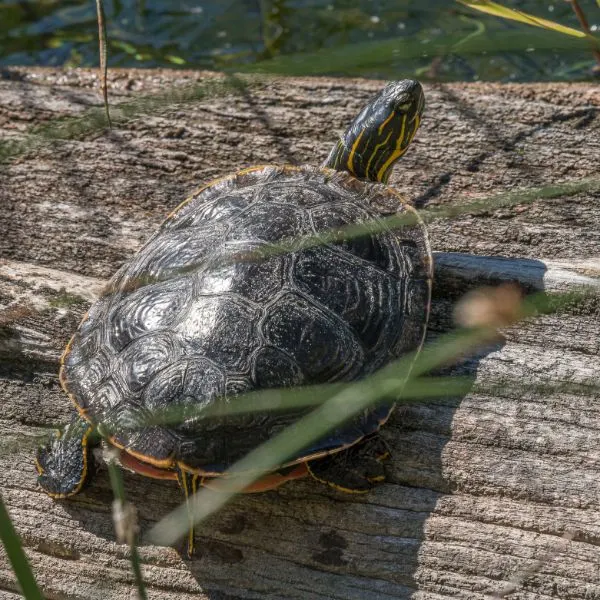
- Experience Level: Beginner
- Family: Emydidae
- Scientific Name: Chrysemys Picta Belli
- Other Names: N/A
- Adult Size: Between 4 and 10 inches
- Lifespan: Between 30 and 50 years
- Average Price Range: Between $30 and $150
Western Painted turtles are found throughout the United States and can be seen in most areas of Washington state. They are the most widely distributed freshwater turtle in North America.
Though they prefer slow-moving waters such as ponds, creeks, lakes, and marshes with muddy, vegetation-covered bottoms, they can adapt to other water conditions.
The most important part of their habitat is finding suitable basking spots. These turtles love to spend time soaking in the warm rays of the sun. Sometimes you can see up to 50 Western painted turtles on a single basking spot.
When they aren’t lazing around in the sun, they can be found at the bottom of the water searching for food. Baby Western painted turtles tend to be more carnivorous than adults.
Juvenile and baby Western painted turtles will feed on crayfish, tadpoles, insects, mollusks such as snails and slugs, and small fish. They will even feed on carrion when it’s available. Adults tend to feed mostly on aquatic vegetation.
Western painted turtles are medium sized turtles that can reach sizes from 4 to 10 inches long from the front of their shells to the back. Females tend to be larger than the males, but the boys have longer and thicker tails.
These turtles can have dark green to black skin, but they have brightly colored, red and yellow stripes along their heads and limbs. Their smooth, slightly domed shells don’t have much decoration. The upper shell (carapace) is usually green or black, and the bottom (plastron) is usually a pale yellow with different shapes and patterns.
The Western painted turtle doesn’t have many predators to contend with when they are full-sized, but as babies, they have plenty to look out for. The introduced largemouth bass for one will eat baby turtles.
Fortunately, the western painted turtle will flail, thrash around, and claw the tender insides of the bass’ mouth. This action usually gets the baby turtle released.
The Western painted turtle is of least concern in Washington state as its numbers are healthy. Unfortunately the same can’t be said about our next turtle on the list.
Pond Sliders in Washington State
2. Western Pond Turtle

- Experience Level: Intermediate to Expert
- Family: Emydidae
- Scientific Name: Actinemys Marmorata
- Other Names: Pacific Pond turtle, Northwestern Pond Turtle
- Adult Size: Between 4 and 9 inches
- Lifespan: Between 30 and 50 years
- Average Price Range: Around $500 (very rare as they are difficult to breed, and illegal to own in many states)
In the 1990s the Western Pond turtle nearly went extinct. It was thought that there were only about 200 left in the wild, separated by two small populations. Their numbers were quickly dwindling.
These turtles are listed as “a Species of Greatest Conservation Need under the State Wildlife Action Plan.”
There are several threats to this turtle’s existence, most from introduced species. The American bullfrog, invasive vegetation that overgrows habitat, and introduced fish like the largemouth bass.
Bullfrogs have voracious appetites and will eat nearly anything they can fit into their huge mouths, this includes baby turtles. The Western pond turtle is only about the size of a quarter when they hatch, making them an easy snack for larger, aquatic predators.
Other threats include habitat loss and egg predation by mammals and other animals that contribute to their dwindling numbers.
Their Numbers Are On The Rise
Thanks to the quick action and help from the state of Washington and partners like the Woodland Park Zoo, they were successful in bringing their number up from only about 200 to over 800 turtles in six different populations as of this year (2022). Read the whole story here.
It’s difficult to accurately keep track of the Western pond turtle numbers because they are a very shy species. Even the slightest noise or disturbance will send them scurrying back into the protection of the water.
Unfortunately, even with controlled breeding and keeping the babies safe until they are no longer snack-sized morsels for bullfrogs and bass, these turtles still are plagued with problems. They often contract shell disease.
There is little known about this disease, but it presents itself on turtles’ shells and progresses to deeply pitted lesions. Eventually, it can bore through the shell and go into the bones beneath. It’s believed that shell disease shortens a turtle’s lifespan.
The Western pond turtle grows 4 to 9 inches long and can live up to 50 years. They have dark brown to olive green shells with light markings on the scutes. Their plastrons are yellow with dark markings.
Their skin is dark brown, but males have a light colored throat.
The Western pond turtle feeds on insects, fish, worms, amphibians, and crustaceans. They also feed on aquatic vegetation, but most of their diet comes from meat sources.
Because of its protective status, this turtle is illegal to keep as a pet in the state of Washington, Oregon, and California. It may be prohibited to keep the Western pond turtle in other states too, so be sure to check local and state laws before acquiring any turtle.
3. Red-eared Slider

- Experience Level: Beginner
- Family: Emydidae
- Scientific Name: Trachemys Scripta Elegans
- Other Names: Water Slider turtle, Red-eared Terrapin
- Adult Size: Between 6 and 8 inches
- Lifespan: Between 20 and 40 years
- Average Price Range: Between $30 and $100
Red-eared Sliders are extremely popular amongst turtle owners. They are easygoing turtles that are very mild mannered. They are intelligent and will often recognize their owners and happily swim up to meet them.
This happy-go-lucky behavior can become quite endearing. This popularity is a double-edged sword as they are often released back into the wild. Here they become invasive species and have a habit of threatening native turtles and end up dwindling native numbers.
Red-eared sliders have dark green shells and cream colored plastrons. Their skin is also dark green but can get darker. This dark coloration is accented by yellow stripes that run from the nose back.
They get their name from the red patches behind their eyes. The markings make them look like they have red ears.
Red-eared sliders prefer warm waters of slow-moving ponds, lakes, and wetlands. Like the Western painted turtle, these aquatic turtles look for warm basking spots where several turtles will often climb on top of and over others to find the best spot.
Reasons Why Red-Eared Sliders Are So Invasive
Red-eared sliders are often mistakenly released into non-native lands. Owners are unable to care for them any longer, or they escape their enclosures and get into the wild where they upset the natural balance of the ecosystem.
The main threat of non-native species is usually disease and illness. The red-eared slider usually has immunity to many diseases that native species do not. When the invaders come in, they spread this disease that weakens native numbers.
Red-eared sliders also feed on the same things native turtles do and breed in the same areas. This reduces available resources for native turtles, causing smaller populations of native species.
4. Common Snapping Turtle
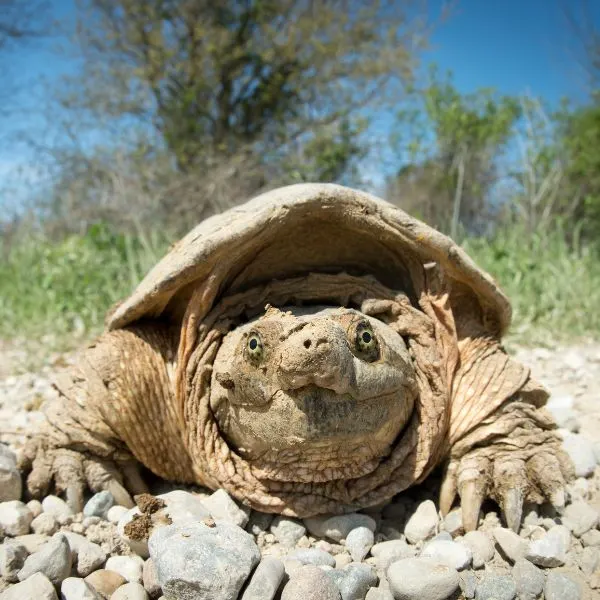
- Experience Level: Intermediate to Expert
- Family: Chelydridae
- Scientific Name: Chelydra Serpentina
- Other Names: Common Snapper, Eastern Snapping turtle, Snapper
- Adult Size: Between 8 and 20 inches
- Lifespan: Between 30 and 50 years
- Average Price Range: Between $40 and $120
The natural habitat of the Common Snapping turtles ranges from Northeastern Canada down to Florida, and as far west as the southern Rocky Mountains. They are not native to Washington state, but they have been found in many waterways in the state.
They can live in nearly any type of freshwater, including brackish, and even polluted waters. The common snapper prefers slow-moving waters with muddy bottoms. This is because they like to hunker down into the mud and wait for food to swim close by.
They spend so much time underwater that their shells often become covered in algae. This helps to camouflage them as they are ambush predators that will strike out with amazing speed to catch fish, mollusks, amphibians, and crustaceans. They have been known to occasionally take small waterfowl from the water.
Common snapping turtles consume a mostly carnivorous diet, but will occasionally eat vegetation.
The snapping turtle is too large to withdraw into its shell, resorting to hissing, biting, or even releasing a foul musk to frighten predators away. Though the only real predators the adult snapping turtles have are humans.
Snapping turtles are sometimes harvested for their meat by people. Snapping turtle meat is the main ingredient in turtle soup which is still consumed in a few places in the United States. There are a few places in Louisiana and Pennsylvania where you may see this dish on restaurant menus.
Their jaws are sharp and have a wicked bite. They have enough strength in their jaws to break bones. Their neck can extend out quite far, so if you see a snapping turtle out of the water, it’s best just to leave it alone.
They aren’t typically aggressive in the water and don’t bite people while underwater, as they prefer to swim away.
It’s easy to recognize the common snapping turtle. They have thick saw-backed shells that have three raised ridges running from front to back. The plastron doesn’t cover much because this turtle has thick, muscular limbs that need a lot of space to move.
Snapping Turtles Don’t Often Leave The Water
Common snapping turtles very rarely leave the water. They don’t even bask in the sun like most other aquatic turtles. To warm up they will float at the top of the water, or stay just under until they reach the desired temperature, then they go back to the bottom.
The only time snapping turtles leave the water is to lay their eggs. When a female is looking for a proper nesting site, they can travel up to a mile away. This is the time they are most vulnerable.
Snapping turtles are slow-moving on land, and they often meet their demise when trying to cross roads. Cars and trucks often run over the slow-moving turtles.
The snapper will usually start laying eggs in June, and then the babies will hatch approximately 90 days later. While on the roads in Washington in the months of June, August, and September, be careful and slow down as you may come across these turtles trying to get across.
Don’t try to help them, because if they bite, it can be extremely painful, and will most likely require a hospital visit. Just let them go on their way.
Softshell Turtles in Washington State
5. Spiny Softshell Turtle
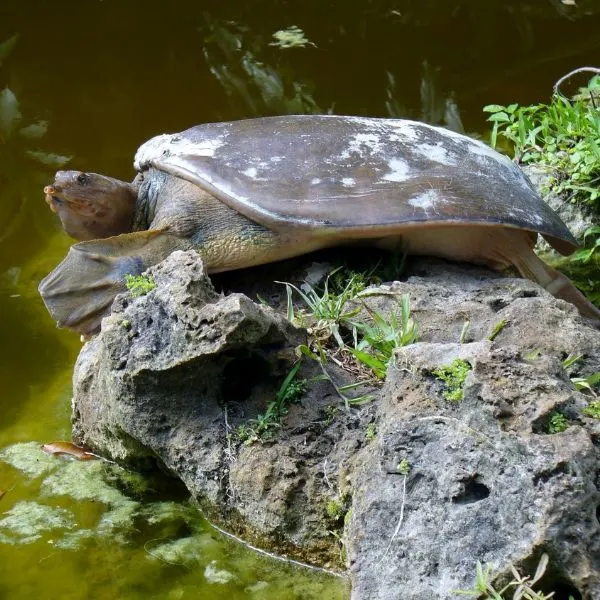
- Experience Level: Intermediate to Expert
- Family: Trionychidae
- Scientific Name: Apalone Spinifera
- Other Names:
- Adult Size: 5 to 9 ½ inches for males, 9 to 20 inches for females
- Lifespan: Between 40 and 60 years
- Average Price Range: Between $50 and $280
For better or for worse, the Spiny Softshell turtle is now a part of Washington state. They typically prefer warmer, or temperate climates, but they can tolerate colder temperatures. As seen by the turtles inhabiting Lake Washington.
Spiny softshell turtles are among the largest freshwater turtle species in North America. The females get considerably larger than males who typically top out at around 10 inches from the front to the back of the shell. Females can get twice as big.
They are called spiny softshell turtles because their shells are flattened and rubbery or leathery in texture. They also have bumps and spikes on the front edges of their shell.
Though their leathery carapace doesn’t offer the protection of harder shelled turtles, these turtles don’t have many predators once they reach adulthood. They also have an aggressive disposition and will scratch and bite if cornered or handled.
Spiny softshell turtles resemble large, green, or tan spotted pancakes. They have nearly flat shells with sometimes brightly colored limbs and heads. Other than their soft shell, they have a long snout.
In shallow water, the spiny softshell turtle will stretch its long neck up and use the snorkel-like snout to breathe air without leaving its hiding place.
These turtles are ambush predators that consume a mostly carnivorous diet. They like to hide in sandy or muddy bottoms of lakes and ponds where they can snatch up food that comes close.
They will eat nearly anything that they can fit into their mouths. Crustaceans, fish, amphibians, insects, and worms are the majority of their diet.
In some states, the spiny softshell turtle is in decline because of habitat loss, pollution, and predators. The spiny softshell turtle has a plethora of predators when it’s a baby. Unfortunately, it’s an introduced, non-native species in Washington state, and as of yet, the impact is not well known.
These turtles are difficult to study and count their numbers as they are typically very skittish. They will quickly jump into the water when they perceive a threat and will quickly swim away. Spiny softshell turtles are accomplished and fast swimmers.
Sea Turtles in Washington State
There are four species of sea turtles that may be seen off the coasts of Washington. Some may nest in places along the beaches, but most of the time they are foraging for food.
Sea turtles are all considered threatened or endangered and are not able to be kept as pets. Not only is it illegal to touch, harass, transport, or own sea turtles, but they simply don’t do well in captivity. There are a few sea turtles kept in zoos and aquariums, but most of these have been injured and wouldn’t survive in the wild.
6. Green Sea Turtle

- Family: Cheloniidae
- Scientific Name: Chelonia Mydas
- Other Names:
- Adult Size: Between 3 and 4 feet
- Weight: Between 300 and 400 lbs
- Lifespan: Between 80 and 100 years
- Conservation Status: Endangered
- Habitat: Bays and shores along coastlines and open ocean waters, seen during summer months
- Clutch Size: Around 110 to 115 eggs, with 2 to 5 clutches per breeding season
- Food: Mostly herbivores, eating algae, sea grasses, and seaweed
- Appearance: Smooth green to brown shells shaped like hearts, edged in yellow. Cream colored scaly skin with shades of green
Green sea turtles are an endangered species. They are slow swimmers that end up getting caught in fishing nets, especially big commercial nets. The netting gets wrapped around their necks and limbs and can cause lesions and infection as the turtle grows.
They have also lost a lot of nesting sites as more people build on beaches. If you live or vacation on or near the beach, be sure to pick up your trash, and turn off the lights after dark. If a sea turtle sees artificial lights when looking for a place to nest, it will move to another place to lay its eggs.
Green sea turtles get their coloration and their name from the foods they eat. These sea turtles eat mostly seagrasses and algae. This diet makes their cartilage and fat green, which is why they are called green sea turtles.
7. Leatherback Turtle
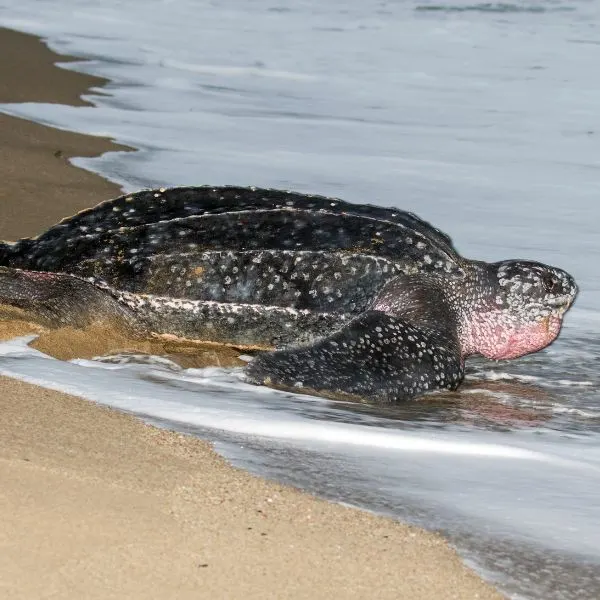
- Family: Dermochelyidea
- Scientific Name: Dermochelys Coriacea
- Other Names:
- Adult Size: Between 6 and 7 feet
- Weight: Between 1200 and 1500 lbs
- Lifespan: Around 30 years
- Conservation Status: Vulnerable
- Habitat: Warm waters, mainly shallow, calm bays or lagoons. Nests are common on sandy beaches.
- Clutch Size: Between 100 and 110 eggs
- Food: Jellyfish is the staple of their diet, but they will also eat other sea creatures
- Appearance: Their large carapaces are soft, and unique among sea turtles, with prominent ridges all the way down. Colors vary between black and dark gray.
Leatherback sea turtles are the largest of all turtles, and the heaviest reptile on the planet, not including crocodilians. They can grow up to 7 feet long and weigh upwards of 1500 pounds. That’s almost a ton!
If you know anything about jellyfish (their main staple) you know that these stinging blobs are mostly water, around 90 to 95 percent. How do these turtles get so big eating something that’s nearly all water?
It’s because they eat so many jellyfish and spend very little energy doing so. Jellyfish are slow and lumbering on the best of days. So turtles spend almost no energy chasing them down, unlike some predators who have to run miles to catch a meal.
The leatherback can also consume massive quantities of jellies as they often congregate in huge numbers. According to The National Library of Medicine, leatherback sea turtles eat an average of 73 percent of their body weight in jellyfish per day.
Even with something as nutrient lacking as jellyfish, when so much is consumed, there is an excess of calories consumed compared to the energy used.
8. Loggerhead Sea Turtle
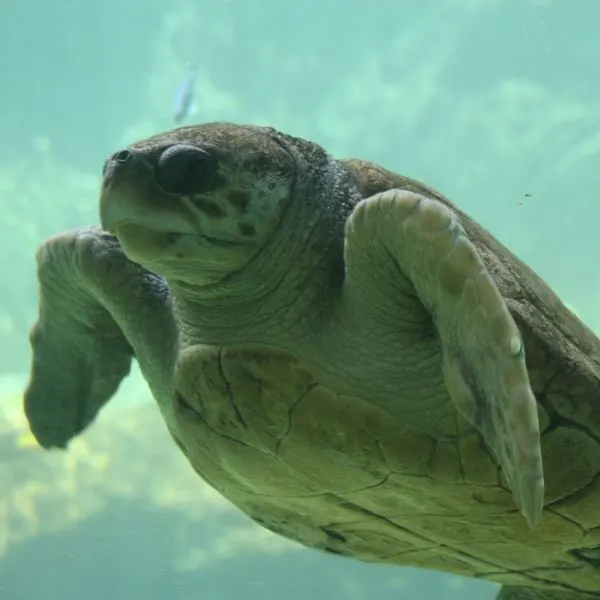
- Family: Cheloniidae
- Scientific Name: Caretta Caretta
- Other Names:
- Adult Size: Between 30 and 45 inches
- Weight: Approximately 155 pounds
- Lifespan: Between 70 and 80 years
- Conservation Status: Endangered
- Habitat: Coastal regions, mainly shallow bays. Prefer sub-tropical waters. Sandy ocean beaches for nesting
- Clutch Size: Between 100 and 125 eggs, 4 to 5 clutches per breeding season
- Food: Carnivorous, mainly eating shellfish, mollusks, and crustaceans
- Appearance: Largest hard-shelled turtles with a reddish-brown carapace and large heads. Undersides are cream to yellowish. Long powerful flippers
The loggerhead sea turtle is the second most abundant of all sea turtles, but it’s still on the endangered species list. Nesting habitat loss, hatchling predation, and fishing nets are the leading causes of population decline in these and most other sea turtles.
These sea turtles eat mostly shellfish including clams, mussels, and horseshoe crabs. They use huge, powerful jaw muscles to break through the hard shells of their prey. These muscles are what make the heads of loggerhead turtles so large.
9. Olive Ridley Sea Turtle

- Family: Cheloniidae
- Scientific Name: Lepidochelys Olivacea
- Other Names: Pacific Ridley sea turtle
- Adult Size: Between 24 and 28 inches
- Weight: Between 75 and 110 lbs
- Lifespan: Around 30 years
- Conservation Status: Vulnerable
- Habitat: Warm tropical seas, shallow coastal waters, mass nesting on sandy beaches
- Clutch Size: Between 75 and 125 eggs
- Food: Crustaceans, shellfish
- Appearance: Triangle-shaped heads. Olive green heart-shaped shells. Green to cream plastrons and undersides.
The Olive Ridley sea turtle is the most abundant of all the sea turtles but is still listed as internationally vulnerable. There are estimated to be nearly 2 million around the world, with about 520,000 nests laid on Indian beaches each year.
They also nest in the warm waters around Mexico, Nicaragua, and Costa Rica. Olive Ridley sea turtles don’t nest on the coastal regions of the United States, but you may see them off the coast of Oregon and Washington during their feeding migration.
These sea turtles will follow prey in the deep waters off the Washington coast. They eat crabs, lobsters, mollusks, and other invertebrates, and can dive up to 500 feet deep in search of food.
Wrapping up
There you have it. All the turtles you might find in the wild, in the untamed state of Washington. Two native species, the Western painted, and Western pond turtle, along with four types of sea turtles you can see in the waters off the shore.
The other turtles are all non-native and introduced species that are doing so well, they are starting to edge out the native species. They are the common snapping turtle, the red-eared slider, and the spiny softshell turtle.
Remember, if you have any pet that you can no longer care for, for any reason, try to find a shelter to care for it instead of releasing it into the wild. While this may seem like a humane action, the consequences can be far-reaching and detrimental to native species.
If you enjoyed this list of Turtles In Washington State, feel free to drop us a comment below!
Other nearby states
